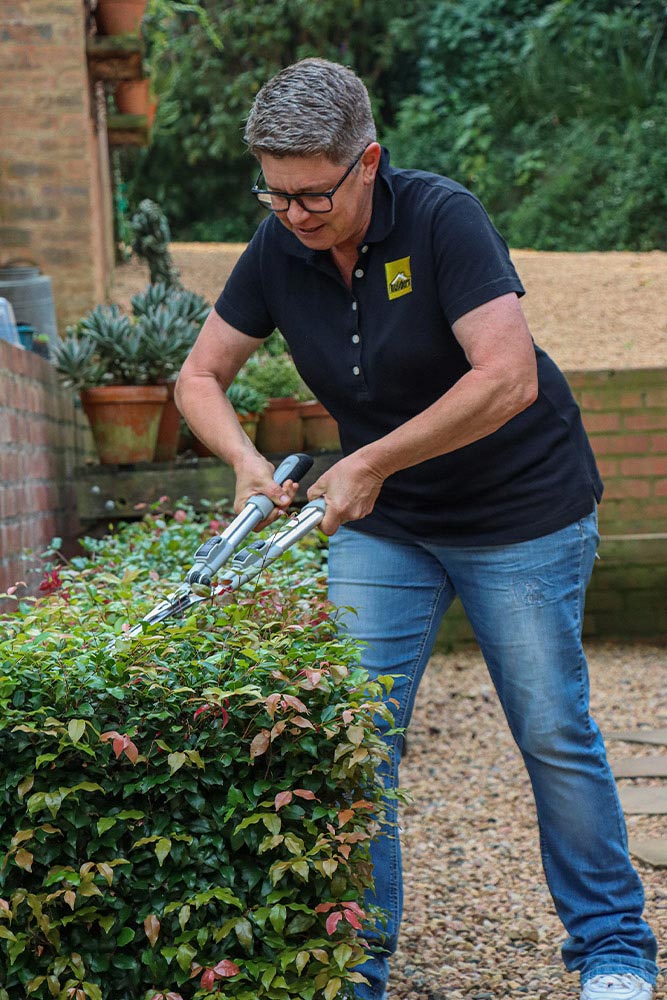Hedges and topiaries are useful in gardening and landscaping for many aesthetic and practical reasons. Here’s how to shape your hedges and topiaries to keep them looking their best.
Many modern gardens have hedges and topiaries in them, to add shape and structure and also to screen or divide garden ‘rooms’. Hedges are also useful to create a privacy barrier from your neighbour. Large hedges of 1.5 m high are surprisingly effective at filtering out sound from a neighbour or road traffic.
Hedges and topiaries need regular pruning to stay neat and the trick here is to trim a little bit at a time. This helps to maintain the shape and also reduces the amount of work you need to do at any one time.
The way you hold your shears is critical in achieving a neat look. If you’re cutting the top of a hedge flat, keep the shears horizontal and just cut off a little foliage at a time. Work slowly and methodically with gentle movements and pause every now and then to shake off the loose vegetation. This will allow the leaves to spring up where they can be cut back.
You should not cut beyond the new growth or into the woody stems, because then you’ll have a patchy hedge. Pruning too drastically will also stress out the plant and either hamper its recovery or even kill it.

When it comes to pruning the sides of a hedge, you want to make the base of the hedge a little wider than the top, even if this does not seem sensible. In this way the plant will receive enough light on the sides and the top, enabling healthy growth. If you trim the top wider than the base, light won’t reach the base and it will most likely either die or grow patchily.
Use a spirit level to ensure that the sides are angled from base to top. Keep the shears at that plane and stop every few minutes to check that you’re going at a constant angle. You’ll have to prune a little off the base to promote regenerative growth but keep it to a minimum.
Topiaries are pruned with similar methods, but we do have another tip for you: turn your shears over when pruning a shaped plant – in this way the shears remove less material at a time and it’s easier to achieve a neat appearance. Again, work your way around the plant removing a little bit at a time and don’t work too fast.
You can’t keep a hedge or topiary looking perfect with the wrong tools – you need a good hedge shear for the job. The Garden Master Premium Telescopic Hedge Shear is just such a tool, with Teflon-coated, hardened-steel blades that glide through leaves and twigs and stay clean for longer. The blades also have a notched edge that helps to grab leaves so that they don’t just slide out of the way when you try to cut them. The telescopic handles are easy to adjust when you’re pruning up high. They’re made of aluminium to reduce the overall weight and the grips are rubberised for fine handling and less hand fatigue. Another nifty feature that keeps your hands and arms from getting tired is the rubber buffer between the handles, which acts as a shock-absorber when you’re cutting.
For smaller, more intricate trimming work, a pair of hand shears can be extremely useful. The Garden Master Premium Hand Shears have heat-treated steel blades for longevity and the serrated edge helps for efficient cutting. The moulded plastic handles are lined with fibreglass for extra strength. These are excellent to keep in the kitchen drawer, so that when you need to cook a few herbs for supper, you can just whip them out and head into your herb garden. They can also be used for deadheading flowers or for neatening up the odd straggling branch.
Remember, the job isn’t done until you’ve cleaned your tools and stored them correctly. We recommend using a spray lubricant for this task – spray some onto a cloth, wipe down the tools, spray a little into the hinge and wipe off any excess before putting away.










